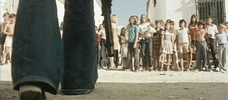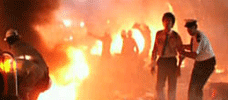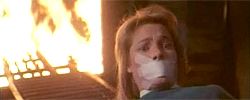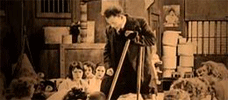Reviews
¿Quién puede matar a un niño? / Island of the Damned
Narciso Ibáñez Serrador
Spain, 1976
Credits
Review by Adam Balz
Posted on 03 October 2007
Source Dark Sky Films DVD
Categories 31 Days of Horror
Who Can Kill a Child?, Narciso Ibáñez Serrador’s second - and last - theatrical work, opens with a seven-minute prologue comprised of newsreel footage: dead bodies, including those of emaciated children, being bulldozed into mass graves during the final days of World War II; a nine-year-old Vietnamese girl running naked down a paved street, her body discolored by Napalm; Nigerian newborns lying curled on dirt patches as a civil war rages around them, their stomachs distended and limbs shockingly withered. The narrator notes that, in each instance of war and repression over the last half-century, including those pictured, children were the greatest victims. And, to help support that assertion, numerical figures move across the screen, right to left, detailing the number of young boys and girls left dead by each conflict. They amount to millions. With such an overwhelming opening scene, you would expect Serrador to use the following 100 minutes to craft a story of shocking carnage, of innocent people caught in the path of something horrific and inexplicable, of survival at all odds. He does, but not in a fashion the opening would have us believe.
Serrador’s view of children is something akin to modern views of animals in that, after centuries of abuse and exploitation, we fear they may one day rise up against us. Much like the “When Animals Attack” subgenre of horror films, Who Can Kill a Child? proposes that children are a sort of universal organization detached from adult society—that they exist collectively, fighting alongside their own when necessary. (Think Hitchcock’s The Birds, George McCowan’s cultish Frogs, or certain films by William Girdler.) We know nothing of Almanzora, the tiny island setting of Serrador’s film, before its young residents decide - without any apparent forethought - to savagely murder every adult. We know only that, as our heroes arrive, they have come in search of harmony away from the larger world.
In Benavis, a tourist hotspot on the Spanish coast, bodies have begun washing up on the beaches. They float towards shore with no visible bite marks, no signs of struggle, and make headlines amid the annual festivities. At the same time, Tom and Evelyn, a husband and wife from England, arrive on vacation; they have two children, left in the care of family back home, and Evelyn is pregnant with their third. The outside world, choked with stories of war and bloodshed, has followed them in the form of news reports, which the couple tries to ignore while buying film. They walk the streets, taking photographs and buying souvenirs, until the day arrives for them to visit Almandoza, an offshore paradise Tom experienced years ago.
The night before they sail, Tom and Evelyn have a discussion about La Dolce Vita. Pausing, she says, cold and abruptly, “You wanted to kill him,” referring to the child in her stomach. “Do you regret it?” He moves to her side, reminding her they already have a son and daughter, but doesn’t propose anything. This lone discussion, begun and finished in under a minute, will become a frame for both as they struggle to leave Almanzora; surrounded by adolescents, bloodthirsty and brandishing medieval weaponry, they will be forced to weigh their morality against the need to survive.
Comparisons are innumerable between Serrador’s film and two other horror mainstays: Wolf Rilla’s 1960 film Village of the Damned and Fritz Kiersch’s 1984 Stephen King adaptation Children of the Corn. And while they have some weight, the differences between them are measures of believability. King’s cornfield hell-spawns are, as the ending tells us, supernatural; the boys and girls, all of whom are sacrificed upon reaching adulthood, are worshippers of “He Who Walks Behind the Rows.” Similarly, John Wyndham’s white-eyed, white-haired Midwich children are telekinetic; they roam in a tight-knit pack, force their violence on others through chilling stares, and talk through a single haunting leader, young Mara. For most of Who Can Kill a Child?, the cause of the bloodthirsty uprising is unknown. We can only infer based on what a middle-aged holdout tells Tom and Evelyn—that, two nights before they arrived, all the children of Almanzora filled the streets, laughing and screaming, and slaughtered the adults, house by house. It’s this same man who, when asked why the islanders didn’t fight back, offers us the titular response.
Soon, though, we are offered a minor hint of paranormality. Tom and Evelyn, having taken refuge in the island countryside with a housewife, suddenly find the woman’s children possessed. Two young leaders from the city have trailed the couple and, through stares, transform the rural preteens into menacing, violence-driven shells. It is the only moment throughout the film that characters are filmed in centered close-ups; Tom is always depicted as a man swallowed by shadows, by natural darkness, while Evelyn remains almost constantly bathed in light. Neither of them is ever given time directly before the camera, eyes focused into the lens. The shift in cinematography is a brief, jolting change, and gives the film some of its most haunting imagery.
The significance of Tom and Evelyn’s late-night discussion comes full-circle when, barricaded in an empty jail cell, Tom shoots a young boy with an automatic rifle. The young boy slumps dead in a window, a gun in his hand; blood runs down the cell’s white walls. Only moments before, as Tom charging a crowd of children with an old military jeep, Evelyn’s sense of morality, maybe even of maternity, surfaced, and she steered the jeep into a wall of barrels. Now, faced with her husband’s actions, she begins to deteriorate. She cries in pain, convinced the child inside her has become polluted by the island’s impenetrable evil will, by a young girl who placed her hands against Evelyn’s swollen tummy minutes after arriving. Tom can’t convince her otherwise, and she wails in his embrace. Soon, she has fallen dead on the floor, at the feet of her husband. The children of Almanzora, frightened by the young boy’s death, have fled.
The final ten minutes are uncompromisingly violent—a Peckinpah climax set against the innocent feel of “Sesame Street.” Tom, having spent an immobile night near the body of his wife, slowly emerges from the jailhouse, the automatic weapon at his side. He had sat in the darkness, disengaging himself from any remaining grain of morality; he knows what must be done to escape the island, and he knows it must be done quickly. So, with the children standing before him, blocking his path, his eyes scan their smiling faces; our eyes are drawn to a young girl and the newborn she is holding. Tom, quietly, returns their expressions and opens fire on them. A line of kids falls to the dirt, and Tom bolts through the gap, ditching the gun and heading for water.
This is not, in spite of the opening sequence, blatant social commentary. As the film ends, we’re offered a frightening possibility for the future, should the Almanzora children reach mainland Europe. The final shot - of these maniacal children starting up Tom’s boat, of the young leaders discussing the world’s children - admonishes Serrador of any moralizing label. He has used the dire, violent nature of human beings - of adults - to craft a genuinely terrifying film about how that ingrained inclination towards war trickles down into the minds of the most innocent—those few million forgotten people who, as the title says, perhaps ironically, no one dares harm.
More 31 Days of Horror
-

Alien
1979 -

The Elephant Man
1980 -

My Bloody Valentine
1981 -

Who Can Kill a Child?
1976 -

Cannibal Holocaust
1980 -

Let Sleeping Corpses Lie
1974 -

John Carpenter’s Vampires
1998 -

Jaws 2
1978 -

A Warning to the Curious
1972 -

Wolf
1994 -

The Survivor
1981 -

Cannibal Ferox
1981 -

The Nights of Terror
1981 -

Death Becomes Her
1992 -

Alice, Sweet Alice
1976 -

Body Double
1984 -

Invocation of My Demon Brother
1969 -

Phantasm II
1988 -

Emanuelle and the Last Cannibals
1977 -

The Wicker Man
1973 -

Maniac Cop
1988 -

The Legend of the 7 Golden Vampires
1974 -

The Penalty
1920 -

Boxing Helena
1993 -

Chew on This
2005 -

Night of the Creeps
1986 -

Night of the Lepus
1972 -

Near Dark
1987 -

Army of Darkness
1992 -

The Brood
1979 -

The Lift
1983 -

Amsterdamned
1988 -

Silent Witness
1999 -

The Shaft
2001
We don’t do comments anymore, but you may contact us here or find us on Twitter or Facebook.



